Trees are an crucial a part of our environment and are a important supply of oxygen. Pine timber, specially, are a popular preference for landscaping because of their splendor and hardiness. Unfortunately, pine bushes are also vulnerable to a number of sicknesses that may reason them to weaken and die. As a homeowner or property proprietor, it is critical to take preventative measures to shield your bushes. In this weblog put up, we can provide you with a complete manual to stopping and treating tree sicknesses in your pine timber. From identifying signs and reasons of not unusual tree diseases to imparting recommendations for correct tree care, we have got you protected. By the give up of this manual, you’ll have the information and gear necessary to maintain your pine bushes healthful and thriving for years to come.
Pines are not just majestic and exquisite additions to our landscapes; they also play a important function inside the average fitness and stability of our ecosystems. These towering timber provide colour, safe haven, and habitat for infinite species of wildlife. They additionally make a contribution to the production of oxygen and assist to mitigate climate change with the aid of absorbing carbon dioxide.
However, like all dwelling organism, pines are liable to various illnesses and infections that could compromise their health or even result in their untimely dying. As accountable tree proprietors and nature lovers, it’s miles our responsibility to take proactive measures to guard our pines from these threats.
The importance of defensive your pines cannot be overstated. Not only does it assist to preserve the splendor and ecological price of these bushes, however it also safeguards the investments we’ve got made in our landscapes. Whether you have a single pine on your backyard or a sprawling pine wooded area, implementing preventive measures and right away addressing any symptoms of ailment is crucial to make sure their durability.
In this complete guide, we are able to discover the various illnesses that may have an effect on pines and delve into effective prevention and remedy techniques. By knowledge the not unusual threats and equipping ourselves with the knowledge and gear to fight them, we are able to create a more healthy surroundings for our pines to thrive.
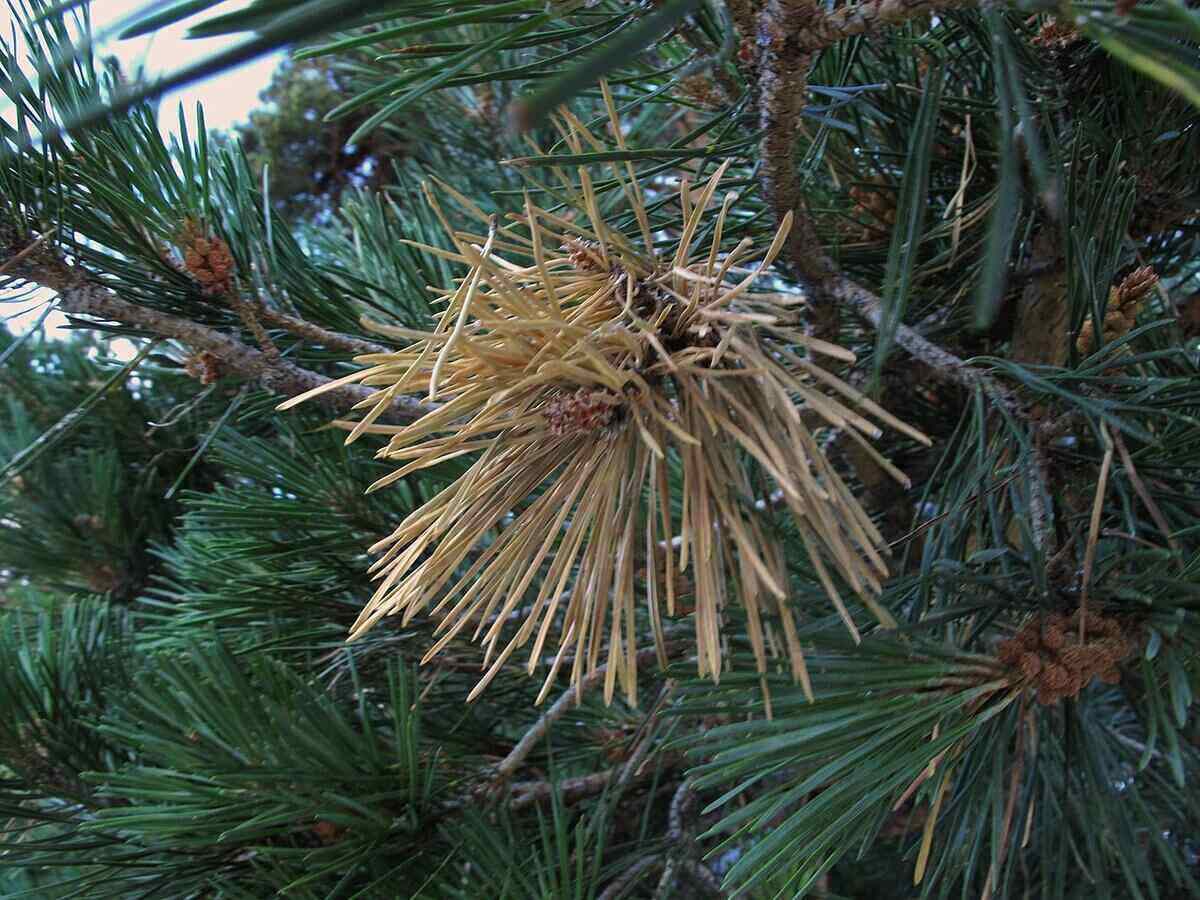
Noticeable needle loss or discoloration in pine timber might be an indication of a diseased tree. However what illness, and how will you deal with your pine tree to restore it to well being? So, should you’re asking your self why your pine timber are turning brown, on this article, we’ll element 10 frequent pine tree illnesses and how to deal with them.
We even have included a tree care professional’s feedback on how to get your pine tree trying inexperienced once more. In spite of everything, pines are evergreen timber, which implies a wholesome pine ought to keep inexperienced all yr lengthy.
Pine Tree Diseases and How to Treat Them
First, it’s important to establish the fungal illness invading your pine tree. The very last thing householders need is a illness spreading to their wholesome timber. An infection can unfold by the soil, air, rain, and even contaminated pruning instruments.
In case you suppose your tree might have a fungal illness, we’ll offer you identification suggestions and clarify how to deal with a pine tree that’s turning brown.
Be aware: Some infections are extra extreme than others and have an effect on completely different pine tree varieties. Take into account that a professional arborist ought to make any prognosis.
In order for you professional recommendation, bounce to the professional feedback of Dr. Curtis L. VanderSchaaf, Forestry Regional Extension Specialist at Mississippi State College Extension.
1. Annosus Root Rot
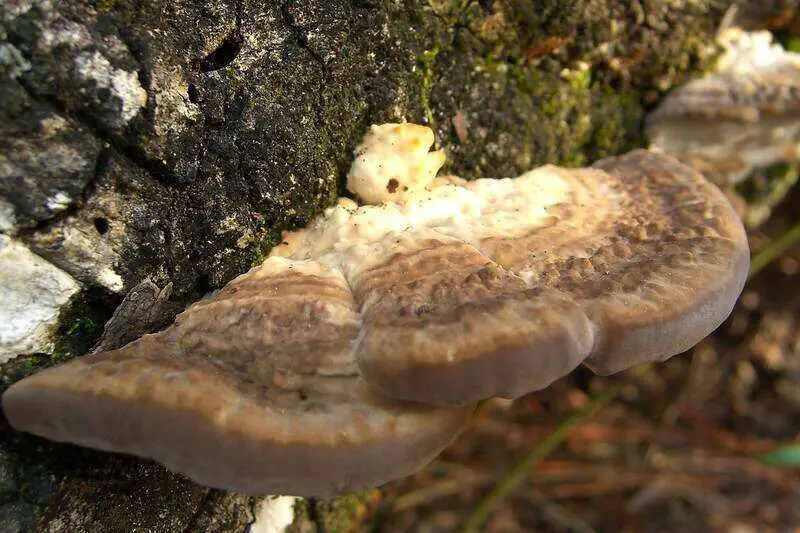

Photograph Credit score: Jason Hollinger / Flickr / CC BY 2.0
Annosus root rot stunts needle progress and causes a decaying situation known as butt rot. This fungal illness is a priority in pine plantations the place thinning has occurred. The freshly minimize stumps following thinning encourage the unfold of this illness. Though this illness leads to dying, there’s a resolution to forestall it from spreading to wholesome pines.
Pine timber affected: This illness impacts these pine timber essentially the most:
- Loblolly
- Slash pines
- White pines
Annosus root rot sometimes infects these pines:
- Shortleaf
- Longleaf
- Ponderosa
- Western white
- Lodgepole
- Whitebark
- Jack
- Pond
- Crimson
- Pitch
- Sand
- Virginia
Signs: Substantial stump decay will happen. The roots and butt develop a smooth, stringy, white rot. The fungus might generate conks or fruiting our bodies on the base of the trunk. These fruiting our bodies fluctuate in form and are between grey-brown and darkish-brown in colour on their floor and white beneath.
Causes: The fungus, Heterobasidion annosum, spreads essentially the most when stumps are freshly minimize. Wind or splashing rain can carry the fungus from contaminated stumps to wholesome timber with minimize surfaces. After touchdown, the spores then penetrate the wooden to set up an an infection.
Infections can stay latent for many years earlier than resuming progress within the pine tree. Stumps and timber with annosus root rot also can infect wholesome timber by their roots.
Remedy: Frequent borax powder utilized to the surfaces of freshly minimize stumps will assist forestall the unfold to neighboring timber. Apply the borax powder in a salt shaker method.
Seasons: Harvesting pines throughout dry summer time and fall months lowers the likelihood for unfold.
Threat degree: This illness is most regarding in forests following thinning, an operation that removes rows of timber. Bushes of all ages can die from this illness, and quantity losses from butt rot will happen in some species. In pines, dying happens after intensive decay.
2. Brown Spot Needle Blight
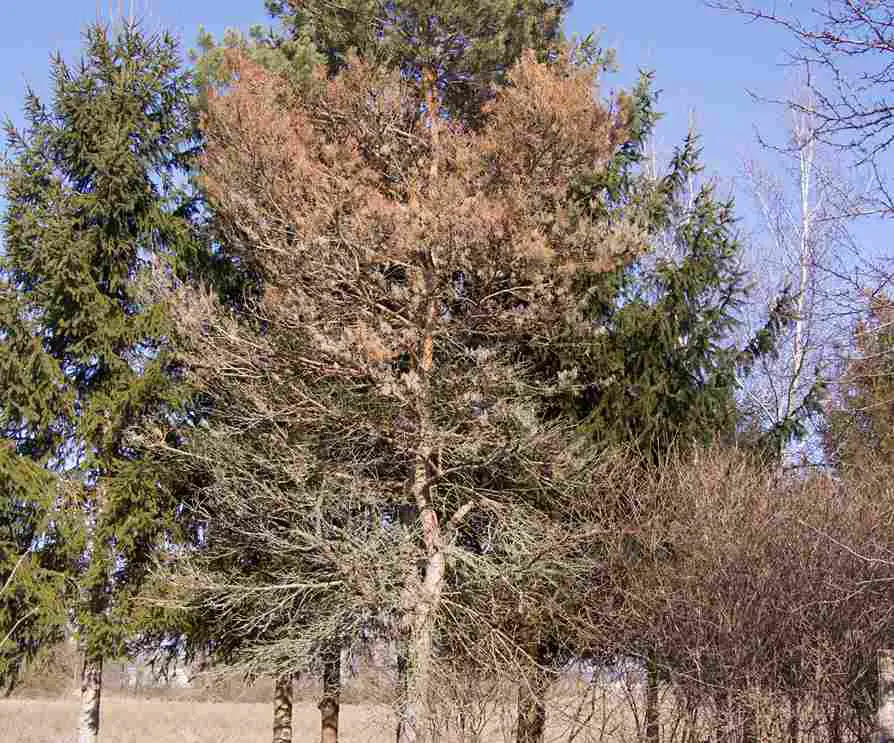

Photograph Credit score: F. D. Richards / Flickr / CC BY-SA 2.0
Brown spot needle blight is a pine tree illness that causes a big drawback for longleaf pine seedlings and Afghan pines grown in Christmas tree nurseries. Signs happen months after infestation and can unfold quickly in allowing climate circumstances.
Pine timber affected:
- Longleaf
- Afghan
- Mugo
- Japanese black
- Virginia
- Jap white
- Crimson
- Austrian
- Scots
Signs: Round grey-inexperienced spots seem on the pine needles within the fall. The spots then enlarge and type slim brown bands encircling the needles. The needles then die and fall off.
Causes: Brown spot needle blight is attributable to the fungus Lecanosticta acicola (previously Mycosphaerella dearnessii). It spreads solely in moist climate. The splashing of rainwater allows the spores to unfold quickly and infect massive areas of the tree. Contaminated pruning instruments also can unfold this illness.
This fungus, together with different pathogens, can be related to white pine needle illness (WPND).
Remedy: Prescribed and managed hearth burning each two or three years eliminates the contaminated needles and kills the infectious spores. Skilled fungicide sprays also can management the fungus.
The Michigan State University Extension recommends making use of fungicide when new needles are about half-grown between Might and June and making use of a second spray three weeks later.
Seasons: Signs seem within the early fall. The fungus spreads throughout heat, moist summer time months.
Threat degree: Nursery seedlings are most prone to an infection when within the grass stage and will usually die from brown spot needle blight. The illness can kill younger pine timber which were contaminated yr after yr.
3. Cotton Root Rot
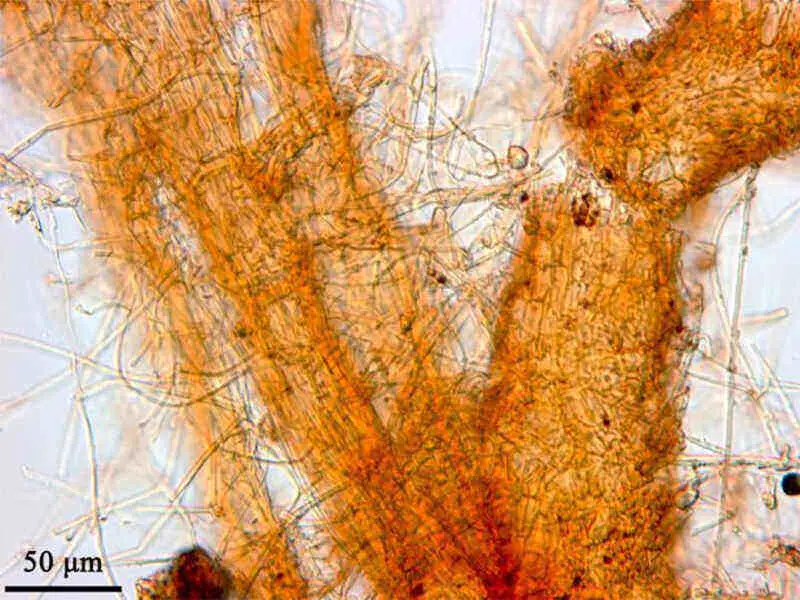

Photograph Credit score: Dr Jose R. Liberato / Wikimedia Commons / CC BY 3.0 AU
Cotton root rot is often known as Phymatotrichum root rot, Texas root rot, and Ozonium root rot. The fungal illness infects greater than 2,000 species of crops and is without doubt one of the most difficult fungal illnesses to management. Cotton root rot is most distinguished within the Southwestern United States.
Pine timber affected: Pines uncovered to excessive temperatures and alkaline soils or soils of limestone origin are most prone, comparable to Afghan pine.
Signs: Signs start with a slight yellowing or bronzing of the host’s leaves. After three days, everlasting wilting happens, adopted by dying. Bushes and shrubs will succumb to the illness extra slowly. Affected areas seem as round patterns of lifeless crops and can step by step enlarge over time.
Causes: Cotton root rot is attributable to the fungus Phymatotrichum omnivorum. The fungus invades new areas by sluggish progress by the soil from plant to plant. The fungus can survive within the soil for a few years and so far as 8 toes deep within the floor.
Remedy: If cotton root rot is infecting your pine, there’s a likelihood of saving the tree if the decay will not be but substantial. The Oklahoma State University Extension recommends this course of:
- Cowl a ridge of soil across the tree’s drip line with a 2-inch layer of natural matter or cow manure.
- Scatter ammonium sulfate and sulfur over the manure.
- Flood the basin with sufficient water to soak the soil to a depth of three toes.
- Preserve the soil moist for a number of weeks.
- The tree is probably going to get better throughout the season.
One other resolution is to plant a resistant grass crop across the contaminated space. The resistant crop creates a barrier that limits the unfold of the illness.
Seasons: Signs often happen from June by September when soil temperatures attain 82 levels Fahrenheit.
Threat degree: This fungal illness can survive within the soil for a few years and kill even your tallest pine timber.
4. Damping-Off
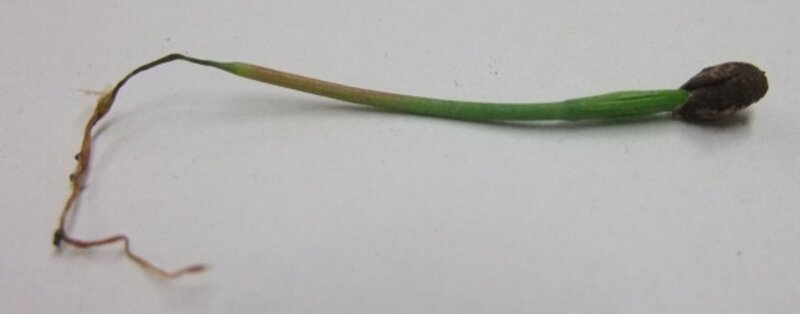

Photograph Credit score: INAKAVillage211 / Wikimedia Commons / CC by SA 3.0
Damping-off is attributable to quite a lot of pathogenic fungi, together with Pythium sp., Rhizoctonia sp., Sclerotium sp., Fusarium sp., and Cylindrocladium sp. Correct prevention strategies are the one method to save your pine seedlings from this illness. These pathogenic fungi often dwell on lifeless natural matter within the soil.
Pine timber affected: Damping-off impacts many plant seedlings. Most kinds of pine tree seedlings are prone to this illness.
Signs: Seedlings failing to emerge from the soil is a symptom of damping-off. If emerged, the decrease stems of the seedling will collapse, and the seedling limps over. Seedling stems might seem water-soaked, smooth, mushy, and discolored. Roots might seem absent or stunted.
Causes: These pathogenic fungi can assault younger seedlings above, beneath, or on the soil line. The illness is most energetic in moist, moist soils. Pine seedlings are prone to the illness for a brief interval and will outgrow their vulnerability.
- Wind, bugs, and water can all carry the infectious spores to the soil.
- Soiled arms, contaminated instruments, or hose ends can add pathogenic fungi.
- As soon as launched, the pathogens transfer from plant to plant.
- Low gentle, overwatering, and over-fertilization can add to the damping-off.
Remedy: Prevention is one of the best ways to management damping-off in plant seedlings:
- Purchase pine seedlings from nurseries with gentle, sandy soils which might be much less prone to pathogen progress.
- Elevate the seedbeds in order that they drain after irrigation and don’t stay too moist.
- Mulch the seedbeds with pine needles.
- Fumigate the soil with an accepted soil fumigant earlier than planting.
- Treat the seeds with a seed-protectant fungicide.
Seasons: Soil temperatures for damping-off fluctuate relying on the pathogenic fungus.
Threat degree: Damping-off is a typical and deadly illness that impacts all kinds of plant seedlings.
5. Diplodia (Sphaeropsis) Tip Blight
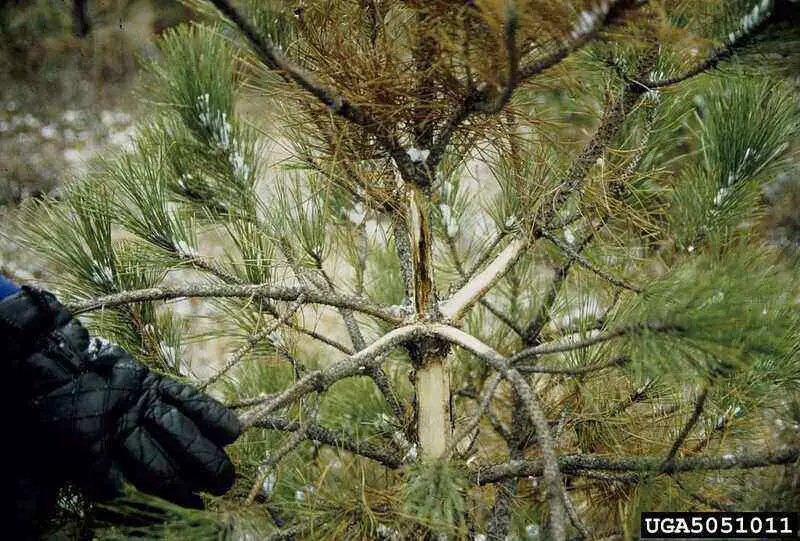

Photograph Credit score: Joseph O’Brien / Wikimedia Commons / CC BY 3.0 US
Previously Sphaeropsis blight (fungus – Sphaeropis sapinea), Diplodia tip blight (fungus — Diplodia pinea) assaults harassed decorative timber in a backyard or yard. Bushes which might be weakened by extreme shade, drought, compacted soils, insect feeding, or different opposed circumstances are generally affected. Diplodia tip blight isn’t seen in forest settings.
Pine timber affected: This illness assaults two-or-three-needled pines comparable to:
- Austrian
- Mugo
- Ponderosa
- Crimson
- Scotch
Signs:
- Needles start to brown, yellow, or grey on the tip.
- Needles will seem quick and stunted.
- Small, black pycnidia (fruiting our bodies) develop on needles, cones, or shoots.
- Cankers on stems and branches might develop.
- Oozing resin might develop.
Causes: The fungus overwinters in contaminated needles, cones, and tissue. Then:
- From March by September, throughout moist circumstances, the pycnidia launch brown spores.
- Wind, water, and animals unfold to wholesome timber.
- The fungus germinates on the needles and rapidly kills the tissue.
- The fungus might enter the needles or the tree by wounds attributable to feeding bugs, climate, and even pruning.
- Within the second yr, cones grow to be contaminated and subsequently unfold the illness.
Remedy:
- Prune contaminated twigs, branches, and cones throughout dry climate.
- Disinfect instruments steadily as you’re pruning.
- Take away and burn or bury the contaminated supplies.
- Apply fungicides in early spring.
- Keep away from extreme fertilization.
- Preserve timber watered throughout drought, however keep away from watering from above.
- Mow across the timber to take away weeds and enable for air to flow into.
Seasons: Diplodia tip blight is current yr-spherical. The fruiting our bodies seem in summer time.
Threat degree: If a canker an infection turns into extreme, it could kill wooden tissue and vital components of the tree. This illness causes essentially the most appreciable harm to timber greater than 30 years outdated. Hardly ever assaults timber below 15 years outdated however could be dangerous to younger seedlings.
6. Dothistroma Needle Blight
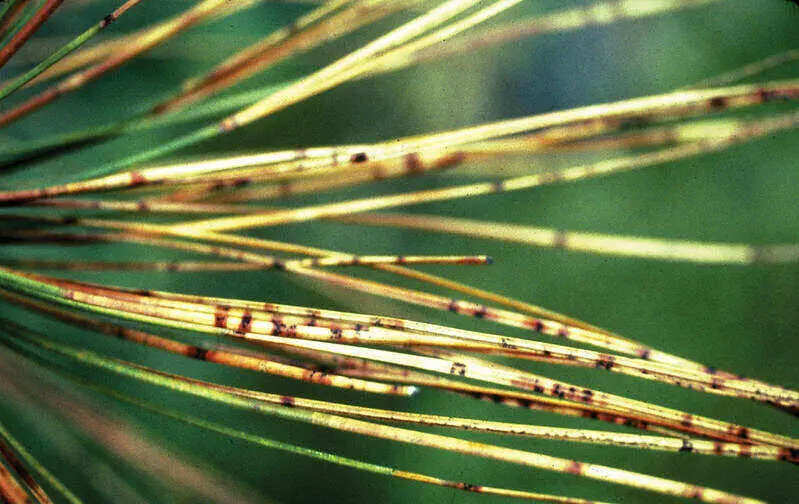

Photograph Credit score: U.S. Department of Agriculture / Flickr / CC BY 2.0
One other pine tree blight, Dothistroma needle blight, additionally known as pink-band needle blight, leads to extreme defoliation. Bushes don’t die instantly from it, however they grow to be weak to blight and assault by creatures comparable to bark beetles.
Pine timber affected: This frequent mugo pine illness (see image) causes essentially the most harm to Austrian pine and Ponderosa pine. Crimson and Scotch pines are additionally prone. Bushes close to rivers, particularly ones in canyons that produce lengthy durations of humidity, are weak.
Signs: Needles over 20 toes excessive are not often affected, however as for the remainder of them:
- Between March and April, the needles on the decrease a part of the tree start to flip brown.
- The needles flip brown on the tip whereas the bottom of the needles stays inexperienced.
- A reddish-brown band seems to type across the needles’ remaining inexperienced.
- Black fruiting our bodies, stromata, could be seen within the bands of the needles.
Causes: The fungus Mycosphaerella pini causes Dothistroma needle blight. The stromata rupture by the dermis of contaminated needles and launch infectious spores. The spores are then unfold by the wind or rain and infect wholesome needles all through the rising season.
Remedy: The University of Minnesota Extension recommends making use of copper fungicides as soon as earlier than buds open within the spring and once more when needles have grown to their full size in the summertime. A number of years of remedy could also be wanted. Pruning contaminated branches and transferring sprinklers away from pine needles additionally cut back the unfold.
Seasons: New infections usually seem in late summer time and fall.
Threat degree: This fungal illness kills needles of all ages and can weaken or ultimately kill your pine timber. It’s a sluggish-transferring illness that takes a full yr to full its life cycle. It usually takes years of repeated an infection to develop a extreme drawback on your tree.
7. Fusiform Rust
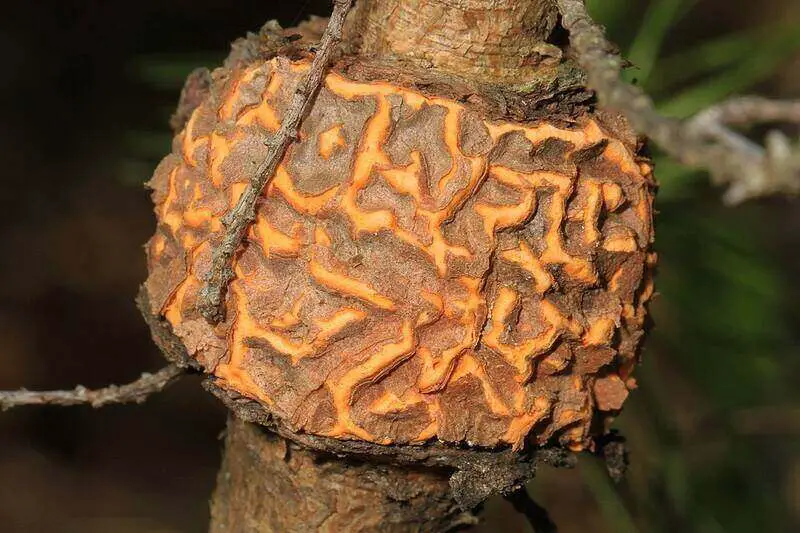

Photograph Credit score: Judy Gallagher / Wikimedia Commons / CC BY 4.0
Fusiform rust is a fungal illness (Cronartium quercuum) that requires two hosts to full its reproductive phases. For this reason this pine fungus additionally manifests as a illness in oak timber. Early speedy tree progress, heat and moist circumstances, and the alternate host’s presence improve the potential of an infection. Fusiform rust is a extreme illness affecting seedlings in nurseries and fields within the southern United States.
Pine timber affected: Slash and loblolly pine are frequent hosts of this illness. Longleaf is reasonably resistant.
Signs: The event of galls, spherical or linear swellings, on branches, and the trunk are an indication of fusiform rust. Stem breakage on the gall is frequent. Galls might become open cankers, that are sunken, injured, brownish-pink lesions.
Causes: The Cronartium quercuum fungus produces 5 spore phases and requires each an oak and a pine tree to full its life cycle:
- Pycniospores seem. They’re honey-coloured droplets that seem on the bark.
- Aeciospores develop a yr later and yearly after that. They’re yellow-orange. They’re blown by the wind so far as 300 miles.
- Urediniospores seem as yellow spots on oak leaves. They’re usually unnoticed. They are going to be produced all through the rising season.
- Teliospores are created by the telia, that are hair-like and pink-brown. They germinate, protruding three or 4 basidiospores which might be taken by the wind.
- Basidiospores (or sporidia) are carried by the wind to pines to begin the illness cycle. They’re small, skinny-walled, and quick-lived.
Remedy: To deal with fusiform rust, landowners can take away the galls by pruning or by eradicating contaminated timber. Seedling nurseries can management this illness with fungicides.
The Alabama A&M and Auburn Universities Extension advises that landowners who plant seedlings make sure that the nursery treats the pine seedlings for fusiform rust. Seedlings contaminated within the nursery is not going to survive greater than a yr or two.
Seasons: The aecia seem on galls in early spring.
Threat degree: Younger pine seedlings contaminated with fusiform rust will die just a few years after leaving the nursery. People who survive will develop deformed. Older timber that survive infections might develop a sunken canker. Cankers on stems could make a stem weak to breaking in excessive wind.
8. Needle Rust
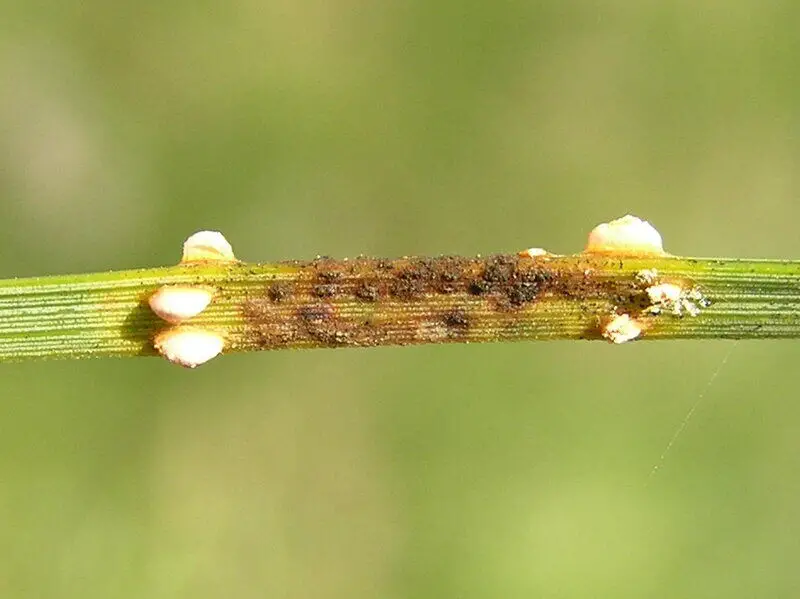

Photograph Credit score: Beentree / Wikimedia Commons / CC BY 4.0
Needle rust is a seldom-seen illness of pine timber. It wants two completely different host crops to full its life cycle — a pine and an aster.
Pine timber affected: Affected pine timber embrace, however are usually not restricted to:
- Austrian
- Jack
- Crimson
- Ponderosa
- Mugo
- Scots
Signs: In pine timber:
- In spring, yellow-to-orange spots or bands seem on inexperienced needles.
- Needles flip yellow.
- In late spring to early summer time, tiny, raised, white tubes type on needles.
- Tubes launch powdery, orange spores.
- Contaminated needles might stay hooked up for a number of years.
- Extreme an infection causes needles to die, flip brown, and fall off.
- Decrease branches of younger timber are most severely affected.
In aster:
- Contaminated leaves develop yellow leaf spots on the higher leaf floor.
- Raised orange spore-stuffed pustules type on the decrease leaf floor.
- In summer time, powdery, yellow-orange spores are produced on the decrease leaf floor.
- In late summer time and fall, darkish brown spores seem inside leaf spots on the decrease leaf floor.
Causes: The fungus Coleosporium asterum causes needle rust. As occurs with many rust fungi, C. asterum wants two completely different host crops, on this case, a pine tree and an aster.
Remedy:
- Reside with the illness. Pine needle rusts do little or no harm.
- Water and mulch. Do that when it’s dry to assist contaminated timber.
- Take away the asters. Pine needle rust wants each pine needles and asters to full its life cycle. Separating the asters from the pines can break the cycle.
- Plant resistant species. Exchange prone pines with white pines, that are resistant, or change to, say, Colorado or Norway spruce, which aren’t pines however are resistant.
Seasons: Needle rust’s life cycle begins within the fall when pine needles are first contaminated. By early spring, the aecia have produced spores to infect adjoining aster leaves. As soon as fall arrives, the spores developed in aster leaves are launched to reinfect the pine needles.
Threat degree: Rust causes minor needle solid and discoloration of needles. Even the extreme instances not often kill timber.
9. Pine Wilt
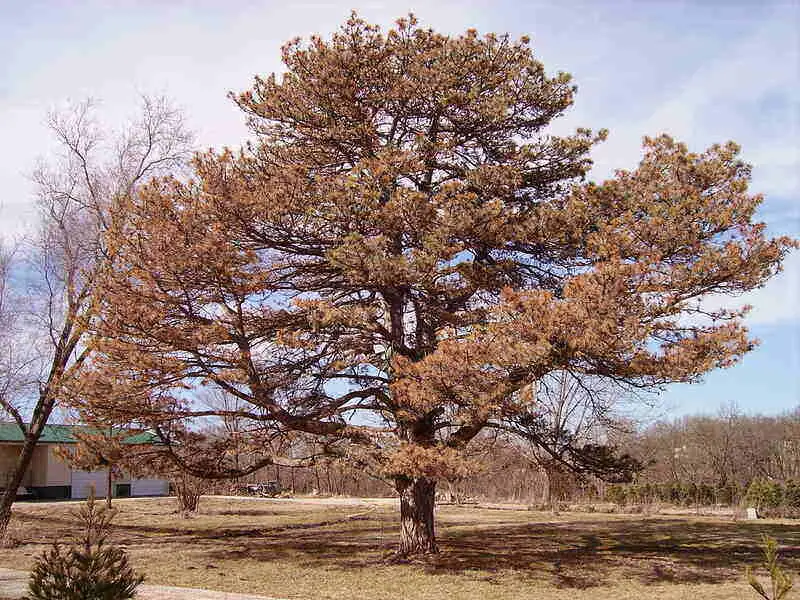

Photograph Credit score: Mateinsixtynine / Wikimedia Commons / CC BY-SA 3.0
Pine wilt is a deadly illness attributable to the pine wilt nematode Bursaphelenchus xylophilus. The pine sawyer beetle carries the nematode to its host. The nematode requires excessive summer time temperatures to develop within the beetle and throughout the tree.
Pine timber affected: Unique pines are prone to an infection:
- Scots
- Austrian
- Mugo
- Japanese pink
- Jap white
Signs: The needles are the primary a part of the tree to present indicators of pine wilt. They flip a grayish-inexperienced, and then a yellow and reddish-brown. The tree will die inside just a few weeks or months after turning this colour.
Causes: Pine sawyer beetles carry pine wilt nematodes from diseased timber to wholesome timber, transferring them as they feed. The nematodes also can infect the host when the beetle lays eggs. The nematodes then multiply throughout the tree and block the pine’s water transport system.
Remedy: Landowners should take away the contaminated pine tree instantly. Chip, burn, or bury the diseased wooden earlier than the emergence of pine sawyer beetles in late June. Don’t save any infested timber for firewood or transportation.
The Colorado State University Extension finds two nematicidal avermectin compounds that deal with pine wilt, however these are directed at nematodes, not the pine sawyer beetle, and require a professional arborist to inject. Additionally, the process will not be helpful if the nematodes have already colonized the tree or whether it is already exhibiting signs.
Seasons: Most pine wilt deaths happen in late summer time or fall.
Threat degree: If landowners haven’t executed prevention strategies, pine wilt will kill infested timber. There is no such thing as a remedy to kill the pine sawyer beetle. As soon as the nematodes have contaminated the pine tree, remedy is just too late. However take motion to forestall additional infestation in adjoining timber.
10. Pitch Canker


Photograph Credit score: Joseph O’Brien, USDA Forest Service, Bugwood.org / Wikimedia Commons / CC BY 3.0 US
Pitch canker is attributable to the fungus Fusarium circinatum. It happens within the southeastern United States, Mexico, Chile, Japan, South Korea, Italy, France, Spain, Portugal, and South Africa.
Pine timber affected: Pitch canker impacts many pine species:
- Monterey pine, essentially the most extensively affected host
- Bishop
- Knobcone
- Grey
- Coulter
- Torrey
- Ponderosa
Signs: The fungus causes:
- Infections (lesions) that may encircle branches, uncovered roots, and trunks
- Wilt within the suggestions of branches since water can’t get by
- Needles to flip yellow and then brown, then fall off
- A number of department infections
- Dieback within the crown
- The trunk above an encirclement to die
The fungus doesn’t transfer throughout the tree, nonetheless:
- Every canker or lesion is a separate an infection.
- The pitch, additionally known as resin, begins to cluster on the contaminated web site.
- Removing of the bark reveals a honey-coloured resin-soaked wooden.
- Resin can circulate alongside the bark to coat areas a number of toes beneath.
Causes:
- The fungus Fusarium circinatum causes pitch canker.
- Engraver beetles may cause additional harm, killing branches, if not the whole pine.
- The resin circulate usually attracts pitch moths, whose infestation can create a bulging mass of accrued pitch.
- Bugs unfold the illness from tree to tree as they feed.
Remedy: One of the best method to pitch canker is to forestall the fungus from transferring to your wholesome timber. If a pine tree will not be severely contaminated, landowners can restrict the unfold by eradicating contaminated branches. It’s important to carry out any pruning with sanitized instruments.
Pesticides are usually not an efficient method to management pitch canker, and there are not any direct strategies that management or deal with the illness.
Threat degree: Pitch canker might lead to extreme harm or dying of your pine tree. But particular person timber are recognized to present resistance; cuttings from them can assist an contaminated tree get better. Nevertheless, timber that are actually resistant may grow to be prone if the fungus strengthens. You may take motion by planting resistant pine timber.
Effective remedies for not unusual pine tree diseases
- When it involves protecting your valuable pine trees, understanding the proper treatments for not unusual tree diseases is critical. These majestic evergreens can fall prey to various illnesses, but with the proper know-how and action, you could successfully combat those diseases and preserve the fitness and beauty of your pines.
- One not unusual pine tree sickness is pine wilt, which is due to a microscopic malicious program referred to as the pine wood nematode. This unfavorable pest can hastily spread at some point of the tree, causing wilting, yellowing needles, and eventual tree dying. To deal with pine wilt, it’s far critical to put off and spoil infected trees right away. Additionally, preventive measures which include properly watering bushes, keeping a healthful soil surroundings, and the usage of insecticides targeting the nematodes can help shield unaffected trees from infestation.
- Another common disease in pine trees is Dothistroma needle blight, characterised by way of brown or reddish-brown bands at the needles. This fungal infection can weaken the tree and lead to defoliation if left untreated. Effective treatments for needle blight consist of pruning inflamed branches, ensuring right tree spacing for appropriate air flow, and making use of fungicides endorsed for Dothistroma manipulate.
- Diplodia tip blight is yet some other sickness that influences pine timber, causing dieback of department hints and brown, resinous cankers. This fungal infection prospers in warm and humid situations. To treat Diplodia tip blight, directly prune and remove infected branches, sell accurate tree fitness via proper pruning and watering, and observe fungicides categorised for Diplodia manipulate.
- It’s vital to observe that effective remedy of tree diseases often includes a mixture of techniques, inclusive of cultural practices, pruning techniques, appropriate use of insecticides, and everyday tracking. Consulting with an authorized arborist or tree professional is recommended for correct prognosis and tailored remedy plans.
Consulting with a professional arborist for prognosis and remedy
- When it involves protecting your valuable pines from diseases, occasionally it is quality to name inside the specialists. Consulting with a professional arborist can offer you with valuable know-how, enjoy, and steering in diagnosing and treating tree diseases effectively. These professional specialists specialize within the care and preservation of bushes, and that they have the understanding to discover diverse illnesses that may be affecting your pines.
- An arborist will behavior an intensive examination of your trees, assessing their ordinary fitness and searching out any symptoms of ailment or pest infestation. They will closely look at the foliage, branches, trunk, and root gadget, the use of their educated eye to discover any abnormalities or potential troubles. Through their considerable understanding, they are able to differentiate among common sicknesses which include pine wilt, needle cast, or root rot, and determine the maximum suitable remedy options.
- Once a analysis is made, the arborist will broaden a custom designed treatment plan tailor-made in your unique state of affairs. This can also involve a aggregate of cultural practices, along with pruning inflamed branches or enhancing soil conditions, in addition to the utility of focused treatments, inclusive of fungicides or insecticides. They may also offer you with pointers for ongoing tree care and protection to save you future disease outbreaks.
- It’s critical to visit a professional arborist when dealing with tree illnesses, as they’ve the vital understanding and get entry to to specialised system and treatments. Attempting to diagnose and deal with tree illnesses to your very own can be volatile, as misdiagnosis or incorrect remedy methods can in addition harm your pines or lead to the spread of sicknesses to different trees in your area.
FAQ About Pine Tree Diseases
When Ought to I Fear About My Pine Bushes?
The primary signs of pine tree issues present up on the leaves or branches. While you take a look at the branches, make it some extent to discover discoloration or wilting. In case you see such indicators, contact a local arborist for a session.
Can a Dying Pine Tree Be Saved?
At a sure level, the tree can’t be saved. In case you see the whole tree altering colours or sap working down, make it some extent to act. It’s possible too late to save that tree, however you may give you the chance to save different timber and crops round it.
Is a Failing Pine Tree Positive to be Diseased?
Not essentially, however until you may have a skilled eye, it’s onerous to diagnose pine tree illnesses precisely. It is likely to be one thing easy: an absence of daylight, for instance. Pine timber want sunshine to thrive; with out it, the branches will begin dying. Prune them, or neighboring timber, to let within the gentle.
My Pine Tree Is Shedding Needles. Ought to I Fear?
Older needles (closest to the trunk) will flip brown and fall off, particularly as youthful needles (on the department suggestions) shade them. That is the life cycle of pine timber. Nevertheless, if the younger needles begin to fall, you could have an insect or illness attacking the tree. If that’s the case, seek the advice of an area arborist. If older needles are falling, no motion is probably going wanted.

